#state of technology
Explore tagged Tumblr posts
Text

Brave New Worlds...
Atari Computers, 1982
#80s ads#tech ads#retro tech#atari computers#1982#1980s#80s#eighties#early 1980s#80s advertising#vintage tech#atairi 400#atari 800#state of technology#atari ads#old computers#vintage computers
311 notes
·
View notes
Text

"Microsoft will shut down the once-popular video conferencing app on May 5, and is encouraging all existing customers to switch to Teams.
“In order to streamline our free consumer communications offerings so we can more easily adapt to customer needs, we will be retiring Skype in May 2025 to focus on Microsoft Teams, our modern communications and collaboration hub,” Microsoft said in a statement."
PCMag
TechCrunch
CNN
#destiel meme news#destiel meme#news#united states#us news#tech industry#technology#tech#microsoft#skype#microsoft teams#communications#computer technology#RIP skype
666 notes
·
View notes
Text
Scientists have developed a new solar-powered system to convert saltwater into fresh drinking water which they say could help reduce dangerous the risk of waterborne diseases like cholera.
Via tests in rural communities, they showed that the process is more than 20% cheaper than traditional methods and can be deployed in rural locations around the globe.
Building on existing processes that convert saline groundwater to freshwater, the researchers from King’s College London, in collaboration with MIT and the Helmholtz Institute for Renewable Energy Systems, created a new system that produced consistent levels of water using solar power, and reported it in a paper published recently in Nature Water.
It works through a process called electrodialysis which separates the salt using a set of specialized membranes that channel salt ions into a stream of brine, leaving the water fresh and drinkable. By flexibly adjusting the voltage and the rate at which salt water flowed through the system, the researchers developed a system that adjusts to variable sunshine while not compromising on the amount of fresh drinking water produced.
Using data first gathered in the village of Chelleru near Hyderabad in India, and then recreating these conditions of the village in New Mexico, the team successfully converted up to 10 cubic meters, or several bathtubs worth of fresh drinking water. This was enough for 3,000 people a day with the process continuing to run regardless of variable solar power caused by cloud coverage and rain.
[Note: Not sure what metric they're using to calculate daily water needs here. Presumably this is drinking water only.]
Dr. Wei He from the Department of Engineering at King’s College London believes the new technology could bring massive benefits to rural communities, not only increasing the supply of drinking water but also bringing health benefits.
“By offering a cheap, eco-friendly alternative that can be operated off the grid, our technology enables communities to tap into alternative water sources (such as deep aquifers or saline water) to address water scarcity and contamination in traditional water supplies,” said He.
“This technology can expand water sources available to communities beyond traditional ones and by providing water from uncontaminated saline sources, may help combat water scarcity or unexpected emergencies when conventional water supplies are disrupted, for example like the recent cholera outbreaks in Zambia.”
In the global rural population, 1.6 billion people face water scarcity, many of whom are reliant on stressed reserves of groundwater lying beneath the Earth’s surface.
However, worldwide 56% of groundwater is saline and unsuitable for consumption. This issue is particularly prevalent in India, where 60% of the land harbors undrinkable saline water. Consequently, there is a pressing need for efficient desalination methods to create fresh drinking water cheaply, and at scale.
Traditional desalination technology has relied either on costly batteries in off-grid systems or a grid system to supply the energy necessary to remove salt from the water. In developing countries’ rural areas, however, grid infrastructure can be unreliable and is largely reliant on fossil fuels...
“By removing the need for a grid system entirely and cutting reliance on battery tech by 92%, our system can provide reliable access to safe drinking water, entirely emission-free, onsite, and at a discount of roughly 22% to the people who need it compared to traditional methods,” He said.
The system also has the potential to be used outside of developing areas, particularly in agriculture where climate change is leading to unstable reserves of fresh water for irrigation.
The team plans to scale up the availability of the technology across India through collaboration with local partners. Beyond this, a team from MIT also plans to create a start-up to commercialize and fund the technology.
“While the US and UK have more stable, diversified grids than most countries, they still rely on fossil fuels. By removing fossil fuels from the equation for energy-hungry sectors like agriculture, we can help accelerate the transition to Net Zero,” He said.
-via Good News Network, April 2, 2024
#water#water scarcity#clean water#saline#desalination#off grid#battery technology#solar power#solar energy#fossil fuels#water shortage#india#hyderabad#new mexico#united states#uk#united kingdom#good news#hope#aquifers
1K notes
·
View notes
Text

Luigi mangione
#news#news update#politics#public news#world news#breaking news#political news#global news#us news#usa news#celebrity news#crypto news#united states#technology#cnn news#usa politics#american politics#donald trump#trump#luigi mangione#luigi is innocent#uhc#deny defend depose#uhc shooter#the adjuster#free luigi#ceo down#uhc ceo#the claims adjuster#united healthcare
148 notes
·
View notes
Text
FCC strikes a blow against prison profiteering

TOMORROW NIGHT (July 20), I'm appearing in CHICAGO at Exile in Bookville.

Here's a tip for policymakers hoping to improve the lives of the most Americans with the least effort: help prisoners.
After all, America is the most prolific imprisoner of its own people of any country in world history. We lock up more people than Stalin, than Mao, more than Botha, de Klerk or any other Apartheid-era South African president. And it's not just America's vast army of the incarcerated who are afflicted by our passion for imprisonment: their families and friends suffer, too.
That familial suffering isn't merely the constant pain of life without a loved one, either. America's prison profiteers treat prisoners' families as ATMs who can be made to pay and pay and pay.
This may seem like a losing strategy. After all, prison sentences are strongly correlated with poverty, and even if your family wasn't desperate before the state kidnapped one of its number and locked them behind bars, that loved one's legal defense and the loss of their income is a reliable predictor of downward social mobility.
Decent people don't view poor people as a source of riches. But for a certain kind of depraved sadist, the poor are an irresistible target. Sure, poor people don't have much money, but what they lack even more is protection under the law ("conservativism consists of the principle that there is an in-group whom the law protects but does not bind, and an out-group whom the law binds but does not protect" -Wilhoit). You can enjoy total impunity as you torment poor people, make them so miserable and afraid for their lives and safety that they will find some money, somewhere, and give it to you.
Mexican cartels understand this. They do a brisk trade in kidnapping asylum seekers whom the US has illegally forced to wait in Mexico to have their claims processed. The families of refugees – either in their home countries or in the USA – are typically badly off but they understand that Mexico will not lift a finger to protect a kidnapped refugee, and so when the kidnappers threaten the most grisly tortures as a means of extracting ransom, those desperate family members do whatever it takes to scrape up the blood-money.
What's more, the families of asylum seekers are not much better off than their kidnapped loved ones when it comes to seeking official protection. Family members who stayed behind in human rights hellholes like Bukele's El Salvador can't get their government to lodge official complaints with the Mexican ambassador, and family members who made it to the USA are in no position to get their Congressjerk to intercede with ICE or the Mexican consulate. This gives Mexico's crime syndicates total latitude to kidnap, torture, and grow rich by targeting the poorest, most desperate people in the world.
The private contractors that supply services to America's prisons are basically Mexican refugee-kidnappers with pretensions and shares listed on the NYSE. After decades of consolidation, the prison contracting sector has shrunk to two gigantic companies: Securus and Viapath (formerly Global Tellink). These private-equity backed behemoths dominate their sector, and have diversified, providing all kinds of services, from prison cafeteria meals to commissary, the prison stores where prisoners can buy food and other items.
If you're following closely, this is one of those places where the hair on the back of your neck starts to rise. These companies make money when prisoners buy food from the commissary, and they're also in charge of the quality of the food in the mess hall. If the food in the mess hall is adequate and nutritious, there's no reason to buy food from the commissary.
This is what economists call a "moral hazard." You can think of it as the reason that prison ramen costs 300% more than ramen in the free world:
https://pluralistic.net/2024/04/20/captive-market/#locked-in
(Not just ramen: in America's sweltering prisons, an 8" fan costs $40, and the price of water went up in Texas prisons by 50% during last summer's heatwave.)
It's actually worse than that: if you get sick from eating bad prison food, the same company that poisoned you gets paid to operate the infirmary where you're treated:
https://theappeal.org/massachusetts-prisons-wellpath-dentures-teeth/
Now, the scam of abusing prisoners to extract desperate pennies from their families is hardly new. There's written records of this stretching back to the middle ages. Nor is this pattern a unique one: making an unavoidable situation as miserable as possible and then upcharging people who have the ability to pay to get free of the torture is basically how the airlines work. Making coach as miserable as possible isn't merely about shaving pennies by shaving inches off your legroom: it's a way to "incentivize" anyone who can afford it to pay for an upgrade to business-class. The worse coach is, the more people you can convince to dip into their savings or fight with their boss to move classes. The torments visited upon everyone else in coach are economically valuable to the airlines: their groans and miseries translate directly into windfall profits, by convincing better-off passengers to pay not to have the same thing done to them.
Of course, with rare exceptions (flying to get an organ transplant, say) plane tickets are typically discretionary. Housing, on the other hand, is a human right and a prerequisite for human thriving. The worse things are for tenants, the more debt and privation people will endure to become home-owners, so it follows that making renters worse off makes homeowners richer:
https://pluralistic.net/2021/06/06/the-rents-too-damned-high/
For Securus and Viapath, the path to profitability is to lobby for mandatory, long prison sentences and then make things inside the prison as miserable as possible. Any prisoner whose family can find the funds can escape the worst of it, and all the prisoners who can't afford it serve the economically important function of showing the prisoners whose families can afford it how bad things will be if they don't pay.
If you're thinking that prisoners might pay Securus, Viapath and their competitors out of their own prison earnings, forget it. These companies have decided that the can make more by pocketing the difference between the vast sums paid by third parties for prisoners' labor and the pennies the prisoners get from their work. Remember, the 13th Amendment specifically allows for the enslavement of incarcerated people! Six states ban paying prisoners at all. North Carolina caps prisoners' wages at one dollar per day. The national average prison wage is $0.52/hour. Prisoners' labor produces $11b/year in goods and services:
https://www.dollarsandsense.org/archives/2024/0324bowman.html
Forced labor and extortion are a long and dishonorable tradition in incarceration, but this century saw the introduction of a novel, exciting way of extracting wealth from prisoners and their families. It started when private telcos took over prison telephones and raised the price of a prison phone call. These phone companies found willing collaborators in local jail and prison systems: all they had to do was offer to split the take with the jailers.
With the advent of the internet, things got far worse. Digitalization meant that prisons could replace the library, adult educations, commissary accounts, letter-mail, parcels, in-person visits and phone calls with a single tablet. These cheaply made tablets were offered for free to prisoners, who lost access to everything from their kids' handmade birthday cards to in-person visits with those kids.
In their place, prisoners' families had to pay huge premiums to have their letters scanned so that prisoners could pay (again) to view those scans on their tablets. Instead of in-person visits, prisoners families had to pay $3-10/minute for a janky, postage-stamp sized video. Perversely, jails and prisons replaced their in-person visitation rooms with rooms filled with shitty tablets where family members could sit and videoconference with their incarcerated loved ones who were just a few feet away:
https://pluralistic.net/2024/02/14/minnesota-nice/#shitty-technology-adoption-curve
Capitalists hate capitalism. The capital classes are on a relentless search for markets with captive customers and no competitors. The prison-tech industry was catnip for private equity funds, who bought and "rolled" up prison contractors, concentrating the sector into a duopoly of debt-laden companies whose ability to pay off their leveraged buyouts was contingent on their ability to terrorize prisoners' families into paying for their overpriced, low-quality products and services.
One particularly awful consequence of these rollups was the way that prisoners could lose access to their data when their prison's service-provider was merged with a rival. When that happened, the IT systems would be consolidated, with the frequent outcome that all prisoners' data was lost. Imagine working for two weeks to pay for a song or a book, or a scan of your child's handmade Father's Day card, only to have the file deleted in an IT merger. Now imagine that you're stuck inside for another 20 years.
This is a subject I've followed off and on for years. It's such a perfect bit of end-stage capitalist cruelty, combining mass incarceration with monopolies. Even if you're not imprisoned, this story is haunting, because on the one hand, America keeps thinking of new reasons to put more people behind bars, and on the other hand, every technological nightmare we dream up for prisoners eventually works its way out to the rest of us in a process I call the "shitty technology adoption curve." As William Gibson says, "The future is here, it's just not evenly distributed" – but the future sure pools up thick and dystopian around America's prisoners:
https://pluralistic.net/2021/02/24/gwb-rumsfeld-monsters/#bossware
My background interest in the subject got sharper a few years ago when I started working on The Bezzle, my 2023 high-tech crime thriller about prison-tech grifters:
https://us.macmillan.com/books/9781250865878/thebezzle
One of the things that was on my mind when I got to work on that book was the 2017 court-case that killed the FCC's rules limit interstate prison-call gouging. The FCC could have won that case, but Trump's FCC chairman, Ajit Pai, dropped it:
https://arstechnica.com/tech-policy/2017/06/prisoners-lose-again-as-court-wipes-out-inmate-calling-price-caps/
With that bad precedent on the books, the only hope prisoners had for relief from the FCC was for Congress to enact legislation specifically granting the agency the power to regulate prison telephony. Incredibly, Congress did just that, with Biden signing the "Martha Wright-Reed Just and Reasonable Communications Act" in early 2023:
https://www.congress.gov/bill/117th-congress/senate-bill/1541/text
With the new law in place, it fell to the FCC use those newfound powers. Compared to agencies like the FTC and the NLRB, Biden's FCC has been relatively weak, thanks in large part to the Biden administration's refusal to defend its FCC nomination for Gigi Sohn, a brilliant and accomplished telecoms expert. You can tell that Sohn would have been a brilliant FCC commissioner because of the way that America's telco monopolists and their allies in the senate (mostly Republicans, but some Democrats, too) went on an all-out offensive against her, using the fact that she is gay to smear her and ultimately defeat her nomination:
https://pluralistic.net/2023/03/19/culture-war-bullshit-stole-your-broadband/
But even without Sohn, the FCC has managed to do something genuinely great for America's army of the imprisoned. This week, the FCC voted in price-caps on prison calls, so that call rates will drop from $11.35 for 15 minutes to just $0.90. Both interstate and intrastate calls will be capped at $0.06-0.12/minute, with a phased rollout starting in January:
https://arstechnica.com/tech-policy/2024/07/fcc-closes-final-loopholes-that-keep-prison-phone-prices-exorbitantly-high/
It's hard to imagine a policy that will get more bang for a regulator's buck than this one. Not only does this represent a huge savings for prisoners and their families, those savings are even larger in proportion to their desperate, meager finances.
It shows you how important a competent, qualified regulator is. When it comes to political differences between Republicans and Democrats, regulatory competence is a grossly underrated trait. Trump's FCC Chair Ajit Pai handed out tens of billions of dollars in public money to monopoly carriers to improve telephone networks in underserved areas, but did so without first making accurate maps to tell him where the carriers should invest. As a result, that money was devoured by executive bonuses and publicly financed dividends and millions of Americans entered the pandemic lockdowns with broadband that couldn't support work-from-home or Zoom school. When Biden's FCC chair Jessica Rosenworcel took over, one of her first official acts was to commission a national study and survey of broadband quality. Republicans howled in outrage:
https://pluralistic.net/2023/11/10/digital-redlining/#stop-confusing-the-issue-with-relevant-facts
The telecoms sector has been a rent-seeking, monopolizing monster since the days of Samuel Morse:
https://pluralistic.net/2024/07/18/the-bell-system/#were-the-phone-company-we-dont-have-to-care
Combine telecoms and prisons, and you get a kind of supermonster, the meth-gator of American neofeudalism:
https://www.nbcnews.com/news/us-news/tennessee-police-warn-locals-not-flush-drugs-fear-meth-gators-n1030291
The sector is dirty beyond words, and it corrupts everything it touches – bribing prison officials to throw out all the books in the prison library and replace them with DRM-locked, high-priced ebooks that prisoners must toil for weeks to afford, and that vanish from their devices whenever a prison-tech company merges with a rival:
https://pluralistic.net/2024/04/02/captive-customers/#guillotine-watch
The Biden presidency has been fatally marred by the president's avid support of genocide, and nothing will change that. But for millions of Americans, the Biden administration's policies on telecoms, monopoly, and corporate crime have been a source of profound, lasting improvements.
It's not just presidents who can make this difference. Millions of America's prisoners are rotting in state and county jails, and as California has shown, state governments have broad latitude to kick out prison profiteers:
https://pluralistic.net/2023/05/08/captive-audience/#good-at-their-jobs

Support me this summer on the Clarion Write-A-Thon and help raise money for the Clarion Science Fiction and Fantasy Writers' Workshop!

If you'd like an essay-formatted version of this post to read or share, here's a link to it on pluralistic.net, my surveillance-free, ad-free, tracker-free blog:
https://pluralistic.net/2024/07/19/martha-wright-reed/#capitalists-hate-capitalism

Image: Cryteria (modified) https://commons.wikimedia.org/wiki/File:HAL9000.svg
CC BY 3.0 https://creativecommons.org/licenses/by/3.0/deed.en
--
Flying Logos (modified) https://commons.wikimedia.org/wiki/File:Over_$1,000,000_dollars_in_USD_$100_bill_stacks.png
CC BY-SA 4.0 https://creativecommons.org/licenses/by-sa/4.0/deed.en
--
kgbo (modified) https://commons.wikimedia.org/wiki/File:Suncorp_Bank_ATM.jpg
CC BY-SA 3.0 https://creativecommons.org/licenses/by-sa/3.0/deed.en
#pluralistic#prison tech#fcc#martin hench#marty hench#the bezzle#captive audiences#carceral state#worth rises#bezzles#Martha Wright-Reed Just and Reasonable Communications Act#capitalists hate capitalism#shitty technology adoption curve
348 notes
·
View notes
Text
"John Walker is an evil War Criminal and unfit to be an Avenger!"
Tony Stark was literally a walking war crime. What y'all yapping about?

#Tony's war crimes include: killing civilians#shooting at fleeing and unarmed opponents#deploying a minor in combat#stealing military technology#creating and using illegal weapons#assaulting US servicemen#illegal survellience#cruel and unusual punishment#illegal incarceration#violating the Accords#invading several soveriegn states#illegal and black market arms sales#any many more#john walker#anti tony stark#mcu#thunderbolts#marvel
60 notes
·
View notes
Text
Meaningful Highlights from Kakashi Retsuden:
Minato catching Kakashi before he falls, the same way Kakashi always does for his students. And Kakashi, even at eight or nine years old, straight out of his father's funeral and before being his student, immediately relaxing when he runs into Minato: His feet tangled beneath him and he pitched forward. Into someone’s back. “You were really strong back there,” a voice told him, and he suddenly saw bright golden hair. He felt his breathing become a little easier. The Yellow Flash of Konoha. Namikaze Minato.
Kakashi describing his current feelings about his father: Now he felt proud from the bottom of his heart to have been born the child of the White Fang of Konoha.
Kakashi wanting to help the people of Redaku in a way that they can sustain themselves, even as he actually is providing a great deal of support through the process: The people of this country had to learn how to stand up and walk under their own strength. Give a starving person bread or teach them how to grow wheat. As Hokage, Kakashi had always chosen the latter.
Kakashi reflecting on his time as Sixth Hokage he eschewed tradition to build something that developed beyond shinobi: A never-ending peace. That was what Kakashi had sought as the Sixth Hokage. An orderly society that would go on and on even when he was not the Hokage, even when the day came when the role of Hokage disappeared. To create a framework so that they would never again fall into the quagmire of war.
The way Kakashi shows that he still views all of the former students taught by him and his friends in a parental and protective way: They had long since reached adulthood, and some were now parents while others were active on the front lines as shinobi. Even so, no matter how many years passed, to Kakashi, they were his precious students and the next generation who needed to be protected. Seeing them having so much fun was enough to ease his heart.
#kakashi retsuden#kakashi hatake#minato namikaze#sakumo hatake#light novels#light novel highlights#kakashi retsuden spoilers#i LOVE that kakashi's parental feelings go beyond team 7. like sai is there but he also feels this way about ino kiba tenten lee and karui#like they're ALL his kids to him#they also explicitly state it's BECAUSE of kakashi that the land of fire had technological + economic development. like it's his influence#for point 4: kakashi also notes that people disliked that he was disrupting the status quo/traditions#but he does it anyway!!! bc that's who he is!!#[sasuke voice] revolution <3#ayesha talks anime#naruto series
492 notes
·
View notes
Text

Retconned Wardi firearms- a basic handgun, a highly decorative ceremonial handgun (belonging to Faiza), and a lance-gun.
Gun tech has officially been nerfed down to hand cannons (press F) (this has been a long time coming but I'd been fallacy of sunk costs-ing myself out of retconning).
Handguns are held similarly to a shotgun, with the butt pressed into the user's shoulder, one hand gripping under the barrel, and the other free to ignite the gunpowder. These represent the most advanced firearms in contemporary usage, both in make and in their use of uniform iron projectiles built to match the gun's bore for greater range and efficiency. Lance-guns are the more basal form, usually larger and mounted with the pole held over the shoulder, and are most effectively used by two people (one to hold and aim, one to light the gunpowder).
The spread of firearms is currently mostly limited to the Eastern Inner Seaway peoples (with some additional distribution via overland trade), and actual manufacture of hand cannons and gunpowder at Significant scale is limited to the region's core powers.
The reason for this limited spread is partially due to specific elements of the technology's history. Gunpowder was first synthesized by Burri alchemists and considered to be the discovery of the legendary divine weapon + solar fire of the deity Inanariya, and its formula (along with techniques for ideally refining its components) remained a closely guarded state secret. It was used predominantly in priestly contexts to generate flame and explosive sounds (in conjunction with earlier practices of generating multicolored flames with use of other chemicals), then integrated into combustible weaponry in the forms of fire lances, which would eventually develop into early handcannons.
The treatment of gunpowder as a guarded sacred or semi-sacred substance continued with Wardi adoption, where knowledge of its making is considered a closed rite. It's name (inya tsatsul or just tsatsul, a derived adoption of the Burri iñazatsūya) still reflects a divine solar association (the Burri word means 'sun's thunder', the Wardi 'inya' invokes the sun, 'tsatsul' is an adapted loanword and has no meaning independent of the substance itself), though its priestly use is now predominantly associated with the firearm'ed Odonii (rather than priests of the solar Face Inyamache). The composition of gunpowder can no longer be regarded as a Secret by any means, though efforts to obscure the methods of its creation are still moderately successful and has kept knowledge of gunpowder manufacture more limited than the total sphere of firearm usage itself.
The actual strongest limiting factor of firearm usage is the rarity of natural saltpeter deposits necessary for making gunpowder. The practice of actively producing saltpeter via nitraries has not been developed anywhere in the setting, and all is instead obtained via natural sources. These sources are rare and limited within the current spread of firearm technology, and result in gunpowder being a limited and expensive substance to produce. The weapons themselves are also very expensive to manufacture (a good quality steel SWORD is far too material-cost prohibitive for most people to own), particularly high quality firearms designed for use with standardized ammunition.
These guns are also very basal, and logistical difficulties in their use (weight, very slow loading and firing speed, high visibility, Relatively low reach and accuracy) along with the restrictive cost of production has kept firearms far from rendering conventional weaponry, armor, and projectiles obsolete (even within the societies that have access to them). They are still, however, very devastating in use within their contemporary context, particularly in that high quality guns have a longer range than the best arrow-based projectiles, and utterly negate most contemporary forms of armor at close range.
#I'd consider the setting to be like.....most closely analogous to like 3rd-1st century BCE earth (in terms of the average scale of#societies + Most of its technology (aside from major exceptions like this) + trade interconnectivity)#There are VERY few Very Big states capable of mass-manufacturing and resource extraction (like nothing the size of#the Roman empire has Ever existed in this setting. The biggest empires aren't even close. Cynozepal has a pretty massive territorial#span so is probably the closest thing but its actual control is highly fragmented along disconnected central hubs)#There's significant seaway trade connections but the Vast majority of transmission of goods is localized (even moreso over land)#So point being firearms have developed '''''earlier''''''' than in IRL history but the conditions that enabled very rapid spread are#not really present (though it's fairly inevitable that they'll become widespread over the next few centuries)#Also the likely trajectory of adaptation is going to be the development of Plate armor (which could absorb/block shots#from some types of firearms More advanced than these).#The types of armor used in this particular region is mostly lamellar/scale/padded fabric/leather and rarely involves#full body protection (using a shield to compensate) so developing thicker and fully protective armor would be the next logical#step in the arms race#I think it would be a fun constructed history for armor technology to outpace these simple firearms enough that they end up largely#abandoned in favor of re-specializing in close combat but I don't really care to plan out the far future that much
79 notes
·
View notes
Text
When it is asserted in Germany that in vitro fertilization and similar technologies are all about helping infertile women, German feminists impatiently brush that claim aside. They are irritated at any suggestion that they ought to take such a claim seriously. It is, they say, a "Deckmantel," which means "cloak," "disguise." In conversations with them, one hears occasional references to the political naivete of Americans who accept such a "Deckmantel" at face value.
German feminists have known all along that the stakes in this issue are high. They are particularly sensitive to the ways in which these technologies can and are beginning to be used to manufacture human beings to specifications and, in the process, to reduce women to breeders or, less elegantly, to raw material for a new manufacturing process.
Unlike U.S. feminists, they organized as a movement on the issue and began spreading their critique beyond the feminist movement.
That the stakes are indeed high became dramatically evident in December 1987.
The German equivalent of the FBI (the 'Bundeskriminalamt") staged thirty-three simultaneous raids, many of them against feminists, throughout the Federal Republic of Germany, December 18 at 4:30 p.m. A total of 430 heavily armed police burst into the workplaces of activists. Fifteen to thirty in a group, the police swept into homes in Cologne, Dortmund, and Düsseldorf. In Essen, Duisburg, Bochum, and Hamburg, the raids were directed overwhelmingly against feminist critics of genetic and reproductive technology, according to Prozessgruppe Hamburg, a watchdog group.
The targeted critics have written and spoken on such issues as in vitro fertilization, amniocentesis, sex predetermination, and genetic engineering. They have actively opposed surrogate motherhood. Many worked together in a massive coalition to stop Noel Keane's attempt to open a branch of his U.S. surrogate business, United Family International, in Frankfurt. (Keane's New York firm arranged the Mary Beth Whitehead surrogate contract.) Their campaign to stop the sale of U.S. women to European men for breeding purposes ended successfully January 6, 1988 when a West German court ordered Keane's business closed, three months after it had opened.
Grounds for the police raids? In many cases, the women were not given any. But the next day, newspapers reported that the police conducted the searches to ascertain whether any of the individuals were members of a terrorist organization. They were specifically looking for a group called Revolutionaren Zellen and its feminist wing, Rota Zora.
The police were operating under Paragraph 129a of the terrorist act, "Support or Membership in a Terrorist Organization."
The women raided were forced to undress. All "non-changeable marks" on their bodies—scars, moles, etc. —were noted down in police records. The women were fingerprinted.
Two well-known and widely respected women were arrested: Ulla Penselin, active in two groups in Hamburg, Women Against Genetic Engineering and another group critiquing population control policies; and Ingrid Strobl, a journalist for eight years with the national feminist magazine, Emma. Strobl is accused of buying a clock used in a bombing attack against Lufthansa offices in Cologne to protest the exploitation of Third World women in the sex-tourism industry. Both women were charged under the terrorist act, Paragraph 129a. Strobl remains in prison while Penselin has since been released.
In the nationwide raids, police confiscated materials from an archive on genetic and reproductive technology established by women in Essen and from private homes and apartments. They seized drafts of the women's speeches, material prepared for seminars, names and addresses of those attending seminars, published work, videos, tapes of radio programs, scientific articles, postcards, brochures and private address books.
The police raids appear to be an attempt to stop the widespread antigenetic technology movement in Germany by linking legal organizations with more militant ones, Maria Mies, author of Patriarchy and Accumulation on a World Scale and professor of sociology at the Fachhochschule in Cologne, told me in a telephone interview from her home.
"No concrete accusation or crime was being investigated," she pointed out. "This means that women doing 'Aufklarungsarbeit,' that is, researching reproductive or genetic engineering or talking about it or giving seminars, are already doing enough to provide a pretext for the attorney general to launch such a police action."
Mies, an organizer of the world's first massive feminist conference against reproductive and genetic technology in Bonn in 1985, said of the police action: "We think it is an effort to criminalize and intimidate the whole protest movement of women against reproductive and genetic engineering and frighten others away from participating in order to prevent the movement from spreading even more widely."
Mies added: "We are planning another conference against reproductive and genetic engineering just to demonstrate that we are continuing our work."
-Gena Corea, “The New Reproductive Technologies” in The Sexual Liberals and the Attack on Feminism
#gena corea#reproductive technologies#German feminism#female oppression#womens history#patriarchal state#anti ivf
126 notes
·
View notes
Text

Failure is not an option...
Western Electric, 1963
#60s ads#vintage ads#tech ads#vintage tech#1963#1960s#60s#sixties#early 1960s#mid 1960s#western electric#60s telephones#60s phones#60s tech#retro tech#60s advertising#vintage advertising#state of technology#magazine ads#life magazine
161 notes
·
View notes
Text

"The timing of the tool’s shutdown, months ahead of a major US presidential election, has drawn concern from groups that relied on CrowdTangle to track the flow of information on social media, including viral falsehoods that have led to real-world harm.
Using CrowdTangle, journalists and researchers could show how many users engaged with a piece of content, which groups supercharged the spread of a post and just how often political and medical misinformation went viral on Facebook and Instagram."
source 1
source 2
source 3
#destiel meme news#destiel meme#news#united states#us news#world news#facebook#instagram#meta#mark zuckerberg#misinformation#disinformation#crowdtangle#technology#tech industry#social media
714 notes
·
View notes
Text
"Namibia is the driest country in Sub-Saharan Africa, and home to two of the world’s most ancient deserts, the Kalahari and the Namib. The capital, Windhoek, is sandwiched between them, 400 miles away from the nearest perennial river and more than 300 miles away from the coast. Water is in short supply.
It’s hard to imagine life thriving in Windhoek, yet 477,000 people call it home, and 99 per cent of them have access to drinking water thanks to technology pioneered 55 years ago on the outskirts of the city. Now, some of the world’s biggest cities are embracing this technology as they adapt to the harshest impacts of climate change. But Namibia leads the way.
How did this come about? In the 1950s, Windhoek’s natural resources struggled to cope with a rapidly growing population, and severe water shortages gripped the city. But disaster forced innovation, and in 1968 the Goreangab Water Reclamation Plant in Windhoek became the first place in the world to produce drinking water directly from sewage, a process known as direct potable reuse (DPR).
That may sound revolting, but it’s completely safe. Dr Lucas van Vuuren, who was among those who pioneered Windhoek’s reclamation system, once said that “water should not be judged by its history, but by its quality”. And DPR ensures quality.
This is done using a continuous multi-barrier treatment devised in Windhoek during eight years of pilot studies in the 1960s. This process – which has been upgraded four times since 1968 – eliminates pollutants and safeguards against pathogens by harnessing bacteria to digest the human waste and remove it from the water. This partly mimics what happens when water is recycled in nature, but Windhoek does it all in under 24 hours...
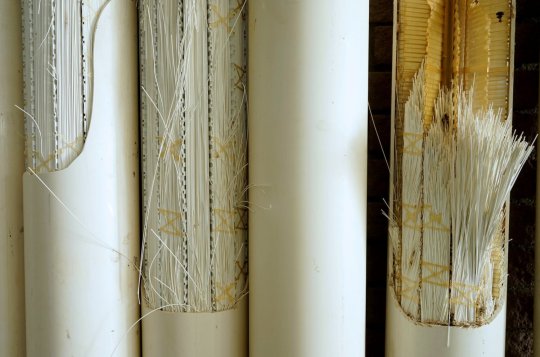
Pictured: These ultrafiltration membranes help to remove bacteria, viruses and pathogens. Image: Margaret Courtney-Clarke
“We know that we have antibiotics in the water, preservatives from cosmetics, anti-corrosion prevention chemicals from the dishwasher,” Honer explains. “We find them and we remove them.”
Honer adds that online instruments monitor the water continuously, and staff ensure that only drinking water that meets World Health Organisation (WHO) guidelines is sent to homes. If any inconsistencies are detected, the plant goes into recycle mode and distribution is halted until correct values are restored.
“The most important rule is, and was, and always will be ‘safety first’,” says Honer. The facility has never been linked to an outbreak of waterborne disease, and now produces up to 5.5m gallons of drinking water every day – up to 35 per cent of the city’s consumption.
Namibians couldn’t survive without it, and as water shortages grip the planet, Windhoek’s insights and experience are more important than ever.
Interest from superpowers across the globe
In recent years, delegations from the US, France, Germany, India, Australia, Singapore, and the United Arab Emirates have visited Windhoek seeking solutions to water shortages in their own countries.
Megadrought conditions have gripped the US since 2001, and the Colorado River – which provides 40 million people with drinking water – has been running at just 50 per cent of its traditional flow. As a result, several states including Texas, California, Arizona and Colorado are beginning to embrace DPR.
Troy Walker is a water reuse practice leader at Hazen and Sawyer, an environmental engineering firm helping Arizona to develop its DPR regulations. He visited Windhoek last year. “It was about being able to see the success of their system, and then looking at some of the technical details and how that might look in a US facility or an Australian facility,” he said. “[Windhoek] has helped drive a lot of discussion in industry. [Innovation] doesn’t all have to come out of California or Texas.”

Pictured: The internal pipes and workings of Namibia's DPR plant. As water becomes scarcer in some parts, countries are looking to DPR for solutions. Image: Margaret Courtney-Clarke
Namibia has also helped overcome the biggest obstacle to DPR – public acceptance. Disgust is a powerful emotion, and sensationalist ‘toilet to tap’ headlines have dismantled support for water reuse projects in the past. Unfortunately, DPR’s biggest strength is also its biggest weakness, as the speed at which water can re-enter the system makes it especially vulnerable to prejudice, causing regulators to hesitate. “Technology has never been the reason why these projects don’t get built – it’s always public or political opposition,” says Patsy Tennyson, vice president of Katz and Associates, an American firm that specialises in public outreach and communications.
That’s why just a handful of facilities worldwide are currently doing DPR, with Windhoek standing alongside smaller schemes in the Philippines, South Africa and a hybrid facility in Big Spring, Texas. But that’s all changing. Drought and increased water scarcity worldwide are forcing us to change the way we think about water.
Now, the US is ready to take the plunge, and in 2025, El Paso Water will begin operating the first ‘direct to distribution’ DPR facility in North America, turning up to 10m gallons of wasterwater per day into purified drinking water – twice as much as Windhoek. San Diego, Los Angeles, California, as well as Phoenix, Arizona are also exploring the technology."
Of course, DPR is not a silver bullet in the fight against climate change. It cannot create water out of thin air, and it will not facilitate endless growth. But it does help cities become more climate resilient by reducing their reliance on natural sources, such as the Colorado River.
As other nations follow in Namibia’s footsteps, Windhoek may no longer take the lead after almost six decades in front.
“But Windhoek was the first,” Honer reminds me. “No one can take that away.”"
-via Positive.News, August 30, 2023
#namibia#africa#desert#water shortage#water conservation#dpr#potable water#water recycling#clean water#drought#united states#colorado river#science and technology#sanitation#good news#hope
2K notes
·
View notes
Text
😱😱😱
#dangerous technologies#dangerous people#alien technologies#war on humanity#crimes against humanity#The deep state’s plan to eliminate 7billion humans#wake up humanity#fight for justice#speaktruth#these people are evil#corruption#standup#speak up#truth#please share#wwg1wga
402 notes
·
View notes
Text
Last month I wrote a post about my intention to get off US tech platforms and services. I’d been considering it for a while, and even taking small steps in that direction, but the alliance between Silicon Valley and Donald Trump, paired with the growing threats from the United States, finally made me take the plunge.
I’m planning to publish a longer list of alternatives for others who want to start shifting away from US tech companies in the near future. But before that, I wanted to provide an update on how things are going. The truth is that getting off the tech services most of us have come to rely on is (probably unsurprisingly) a challenging task because there’s only so much an individual can do to push back on structural forces and a purposeful limitation on the choices available to us.
40 notes
·
View notes
Text
Huh. When out of those 186 drones Russians sent at us two days ago (was it two days ago?🤔 I lost track of time with the new puppy I got), 95 were "lost and unable to radiolocate", I was basically like "🤨🤨🤨 Huh? How do you lose 95 drones??"
But now it makes sense! We have finally figured out how to hack them and send them back to Russia!
Are we awesome? Yes, we are awesome☺️🇺🇦
#ukraine#technology#electronics#electronic warfare#drone#shahed drones#russian invasion of ukraine#war in ukraine#russia is a terrorist state#україна#укртумбочка#укртумба#укртамблер#imperialism#colonialism#genocide
66 notes
·
View notes
Text
April 14, Xi'an, China, Shaanxi History Museum, Qin and Han Dynasties Branch (Part 3 – Innovations and Philosophies):
(Edit: sorry this post came out so late, I got hit by the truck named life and had to get some rest, and this post in itself took some effort to research. But anyway it's finally up, please enjoy!)
A little background first, because this naming might lead to some confusions.....when you see location adjectives like "eastern", "western", "northern", "southern" added to the front of Zhou dynasty, Han dynasty, Song dynasty, and Jin/晋 dynasty, it just means the location of the capital city has changed. For example Han dynasty had its capital at Chang'an (Xi'an today) in the beginning, but after the very brief but not officially recognized "Xin dynasty" (9 - 23 AD; not officially recognized in traditional Chinese historiography, it's usually seen as a part of Han dynasty), Luoyang became the new capital. Because Chang'an is geographically to the west of Luoyang, the Han dynasty pre-Xin is called Western Han dynasty (202 BC - 8 AD), and the Han dynasty post-Xin is called Eastern Han dynasty (25 - 220 AD). As you can see here, in these cases this sort of adjective is simply used to indicate different time periods in the same dynasty.
Model of a dragonbone water lift/龙骨水车, Eastern Han dynasty. This is mainly used to push water up to higher elevations for the purpose of irrigation:
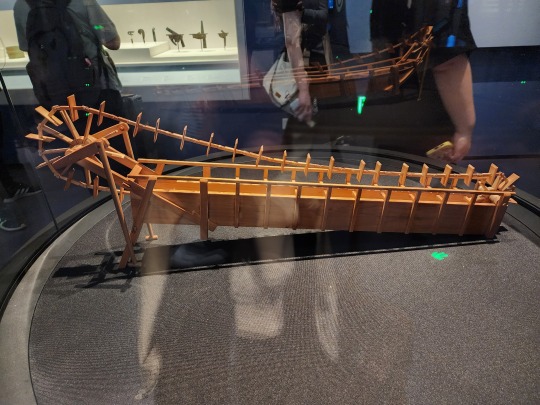
Model of a water-powered bellows/冶铁水排, Eastern Han dynasty. Just as the name implies, as flowing water pushes the water wheel around, the parts connected to the axle will pull and push on the bellows alternately, delivering more air to the furnace for the purpose of casting iron.
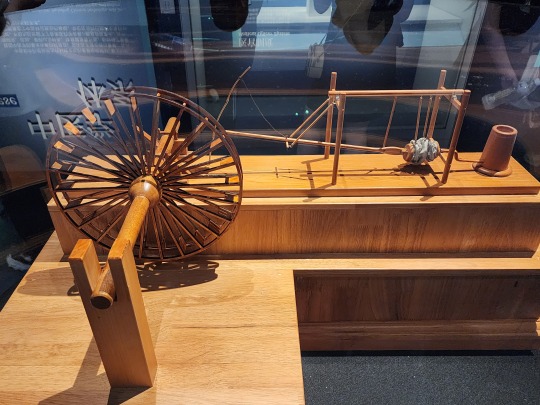
The Nine Chapters on the Mathematical Art/《九章算术》, Fangcheng/方程 chapter. It’s a compilation of the work of many scholars from 10 th century BC until 2 nd century AD, and while the earliest authors are unknown, it has been edited and supplemented by known scholars during Western Han dynasty (also when the final version of this book was compiled), then commented on by scholars during Three Kingdoms period (Kingdom of Wei) and Tang dynasty. The final version contains 246 example problems and solutions that focus on practical applications, for example measuring land, surveying land, construction, trading, and distributing taxes. This focus on practicality is because it has been used as a textbook to train civil servants. Note that during Han dynasty, fangcheng means the method of solving systems of linear equations; today, fangcheng simply means equation. For anyone who wants to know a little more about this book and math in ancient China, here’s an article about it. (link goes to pdf)
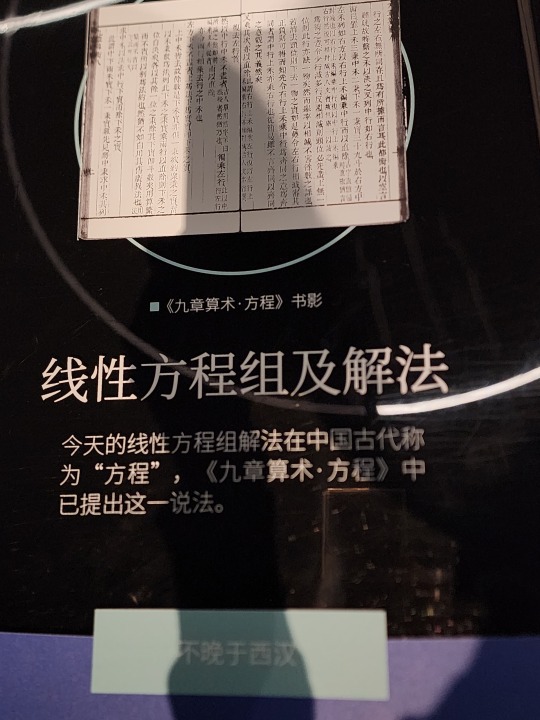
Diagram of a circle in a right triangle (called “勾股容圆” in Chinese), from the book Ceyuan Haijing/《测圆海镜》 by Yuan-era mathematician Li Ye/李冶 (his name was originally Li Zhi/李治) in 1248. Note that Pythagorean Theorem was known by the name Gougu Theorem/勾股定理 in ancient China, where gou/勾 and gu/股 mean the shorter and longer legs of the right triangle respectively, and the hypotenuse is named xian/弦 (unlike what the above linked article suggests, this naming has more to do with the ancient Chinese percussion instrument qing/磬, which is shaped similar to a right triangle). Gougu Theorem was recorded in the ancient Chinese mathematical work Zhoubi Suanjing/《周髀算经》, and the name Gougu Theorem is still used in China today.

Diagram of the proof for Gougu Theorem in Zhoubi Suanjing. The sentence on the left translates to "gou (shorter leg) squared and gu (longer leg) squared makes up xian (hypotenuse) squared", which is basically the equation a² + b² = c². Note that the character for "squared" here (mi/幂) means "power" today.

This is a diagram of Zhang Heng’s seismoscope, called houfeng didong yi/候风地动仪 (lit. “instrument that measures the winds and the movements of the earth”). It was invented during Eastern Han dynasty, but no artifact of houfeng didong yi has been discovered yet, this is presumably due to constant wars at the end of Eastern Han dynasty. All models and diagrams that exist right now are what historians and seismologists think it should look like based on descriptions from Eastern Han dynasty. This diagram is based on the most popular model by Wang Zhenduo that has an inverted column at the center, but this model has been widely criticized for its ability to actually detect earthquakes. A newer model that came out in 2005 with a swinging column pendulum in the center has shown the ability to detect earthquakes, but has yet to demonstrate ability to reliably detect the direction where the waves originate, and is also inconsistent with the descriptions recorded in ancient texts. What houfeng didong yi really looks like and how it really works remains a mystery.
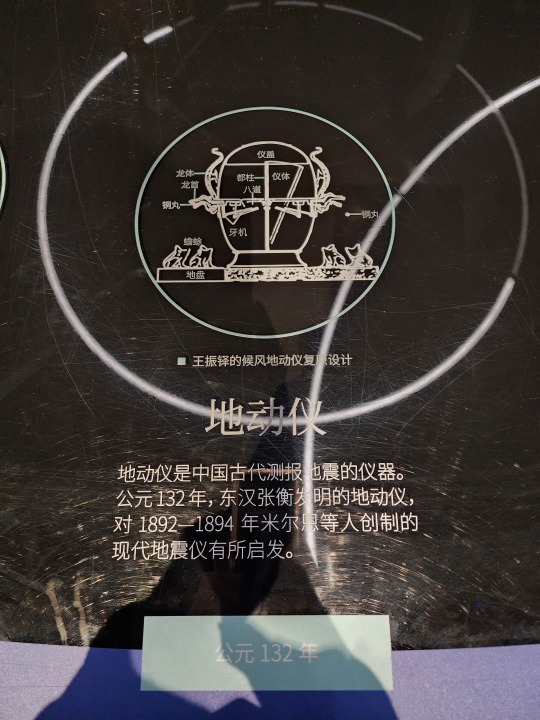
Xin dynasty bronze calipers, the earliest sliding caliper found as of now (not the earliest caliper btw). This diagram is the line drawing of the actual artifact (right).


Ancient Chinese "Jacquard" loom (called 提花机 or simply 花机 in Chinese, lit. "raise pattern machine"), which first appeared no later than 1st century BC. The illustration here is from the Ming-era (1368 - 1644) encyclopedia Tiangong Kaiwu/《天工开物》. Basically it's a giant loom operated by two people, the person below is the weaver, and the person sitting atop is the one who controls which warp threads should be lifted at what time (all already determined at the designing stage before any weaving begins), which creates patterns woven into the fabric. Here is a video that briefly shows how this type of loom works (start from around 1:00). For Hanfu lovers, this is how zhuanghua/妆花 fabric used to be woven, and how traditional silk fabrics like yunjin/云锦 continue to be woven. Because it is so labor intensive, real jacquard silk brocade woven this way are extremely expensive, so the vast majority of zhuanghua hanfu on the market are made from machine woven synthetic materials.

Chinese purple is a synthetic pigment with the chemical formula BaCuSi2O6. There's also a Chinese blue pigment. If anyone is interested in the chemistry of these two compounds, here's a paper on the topic. (link goes to pdf)

A list of common colors used in Qin and Han dynasties and the pigments involved. White pigment comes from chalk, lead compounds, and powdered sea shells; green pigment comes from malachite mineral; blue pigment usually comes from azurite mineral; black comes from pine soot and graphite; red comes from cinnabar; ochre comes from hematite; and yellow comes from realgar and orpiment minerals.

Also here are names of different colors and shades during Han dynasty. It's worth noting that qing/青 can mean green (ex: 青草, "green grass"), blue (ex: 青天, "blue sky"), any shade between green and blue, or even black (ex: 青丝, "black hair") in ancient Chinese depending on the context. Today 青 can mean green, blue, and everything in between.

Western Han-era bronze lamp shaped like a goose holding a fish in its beak. This lamp is interesting as the whole thing is hollow, so the smoke from the fire in the lamp (the fish shaped part) will go up into the neck of the goose, then go down into the body of the goose where there's water to catch the smoke, this way the smoke will not be released to the surrounding environment. There are also other lamps from around the same time designed like this, for example the famous gilt bronze lamp that's shaped like a kneeling person holding a lamp.

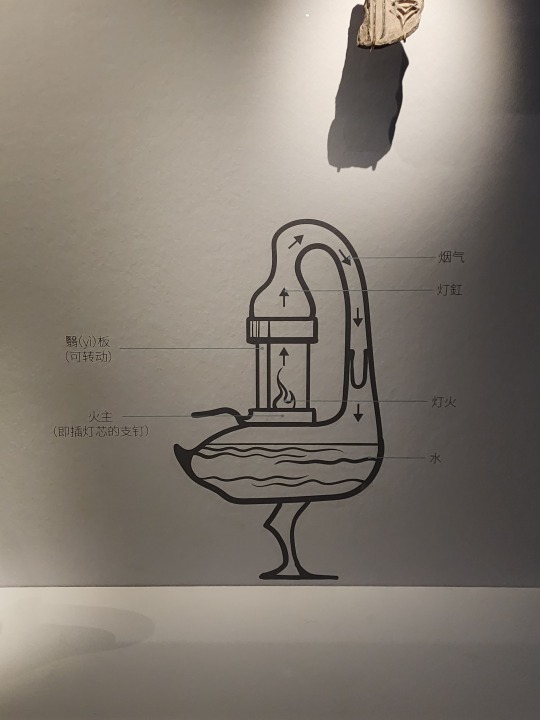
Part of a Qin-era (?) clay drainage pipe system:
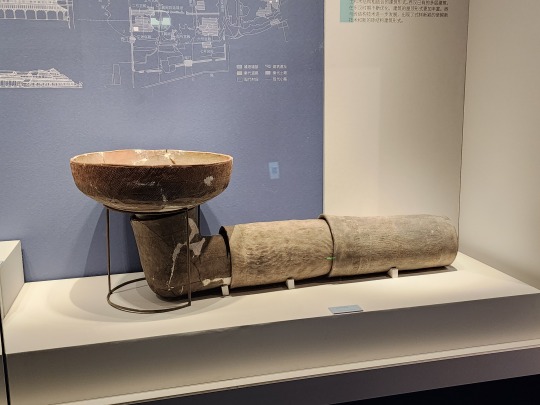
A list of canals that was dug during Warring States period, Qin dynasty, and pre-Emperor Wu of Han Han dynasty (475 - 141 BC). Their purposes vary from transportation to irrigation. The name of the first canal on the list, Hong Gou/鸿沟, has already become a word in Chinese language, a metaphor for a clear separation that cannot be crossed (ex: 不可逾越的鸿沟, meaning "a gulf that cannot be crossed").
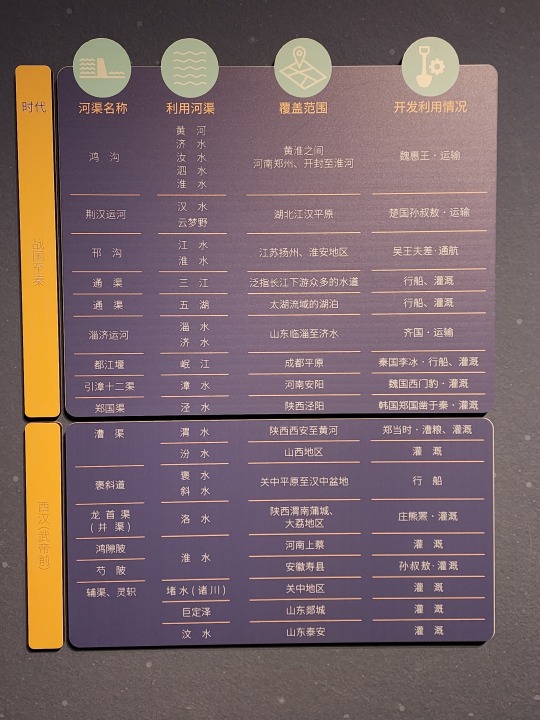
Han-era wooden boat. This boat is special in that its construction has clear inspirations from the ancient Romans, another indication of the amount of information exchange that took place along the Silk Road:

A model that shows how the Great Wall was constructed in Qin dynasty. Laborers would use bamboo to construct a scaffold (bamboo scaffolding is still used in construction today btw, though it's being gradually phased out) so people and materials (stone bricks and dirt) can get up onto the wall. Then the dirt in the middle of the wall would be compressed into rammed earth, called hangtu/夯土. A layer of stone bricks may be added to the outside of the hangtu wall to protect it from the elements. This was also the method of construction for many city walls in ancient China.

A list of the schools of thought that existed during Warring States period, their most influential figures, their scholars, and their most famous works. These include Confucianism (called Ru Jia/儒家 in Chinese; usually the suffix "家" at the end denotes a school of thought, not a religion; the suffix "教" is that one that denotes a religion), Daoism/道家, Legalism (Fa Jia/法家), Mohism/墨家, etc.

The "Five Classics" (五经) in the "Four Books and Five Classics" (四书五经) associated with the Confucian tradition, they are Shijing/《诗经》 (Classic of Poetry), Yijing/《易经》 (also known as I Ching), Shangshu/《尚书》 (Classic of History), Liji/《礼记》 (Book of Rites), and Chunqiu/《春秋》 (Spring and Autumn Annals). The "Four Books" (四书) are Daxue/《大学》 (Great Learning), Zhongyong/《中庸》 (Doctrine of the Mean), Lunyu/《论语》 (Analects), and Mengzi/《孟子》 (known as Mencius).

And finally the souvenir shop! Here's a Chinese chess (xiangqi/象棋) set where the pieces are fashioned like Western chess, in that they actually look like the things they are supposed to represent, compared to traditional Chinese chess pieces where each one is just a round wooden piece with the Chinese character for the piece on top:
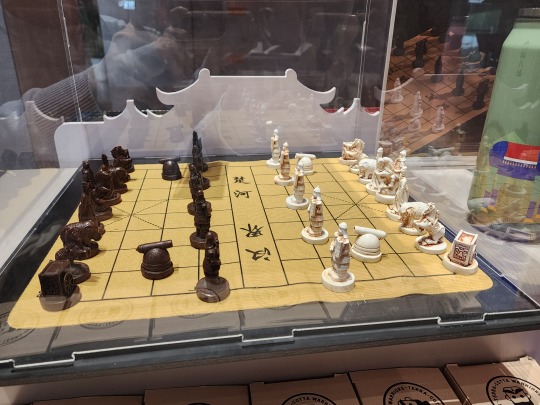
A blind box set of small figurines that are supposed to mimic Shang and Zhou era animal-shaped bronze vessels. Fun fact, in Shang dynasty people revered owls, and there was a female general named Fu Hao/妇好 who was buried with an owl-shaped bronze vessel, so that's why this set has three different owls (top left, top right, and middle). I got one of these owls (I love birds so yay!)


And that concludes the museums I visited while in Xi'an!
#2024 china#xi'an#china#shaanxi history museum qin and han dynasties branch#chinese history#chinese culture#chinese language#qin dynasty#han dynasty#warring states period#chinese philosophy#ancient technology#math history#history#culture#language
98 notes
·
View notes